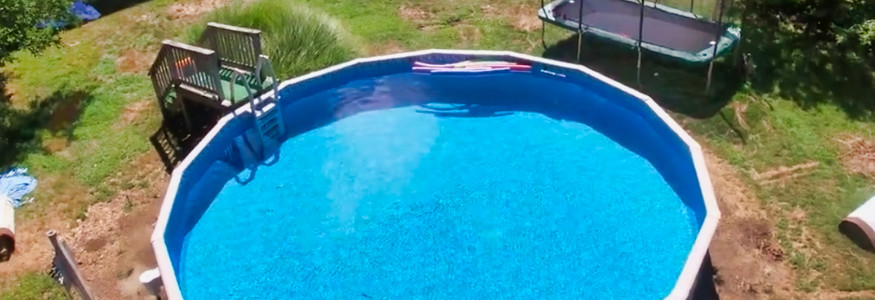
Gorilla Leaf Rake
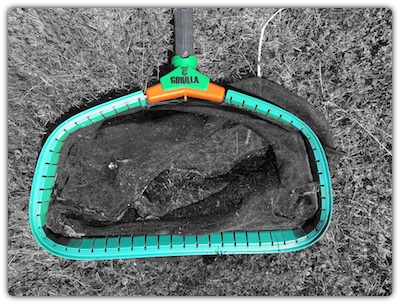
A few years ago, I needed to buy a new leaf rake because the previous one had too many holes and it just wasn't getting as much leaves as it use to.
When I visited the local pool store I was surprised that they only had Gorilla Pool Leaf rakes in stock. More surprising was that they cost $35.
Ouch!
Seriously? A simple piece of plastic with a net on it is worth $35?
When I took the leaf rake off the shelf, I noticed something. This particular leaf rake netting is way stronger than the one I was using. Also, the net end points are double sowed making it
Maybe this one won't tear as easy when I try to scoop up little twigs from the bottom of the pool.
The top had a steeper slope making it much easier to scoop the leaves at the bottom of the pool. Now I can really get all the leaves when I scoop the pool.
I thought about it for a few minutes and decided that this one was worth the investment.
Three years later.
Today my Gorilla Leaf rake is still going strong. There are no holes or any signs of wear and tear. It looks brand new, and that's after three years of pulling out leaves and junk from the bottom of the pool.
I would highly recommend investing in a quality pool leaf rake. This year I pulled out a lot of very heavy wet leaves and I am ever thankful for having a good leaf rake.
Tips on using a Leaf Rake
- When you have a full basket of wet leaves, make sure to hold the bottom of the basket with your hand as you pull it out of the pool. This will help reduce the amount of stress on the pole and the leaf rake connection point.
- This year I went into the pool used the leaf rake attached to a small pole to clean the bottom of the pool. I found that I was able to get more leaves by sweeping the bottom of the pool. The deep basket allows me to not as stop as often to check the basket.
- At the end of the season, I keep the leaf rake above the floor. This is to prevent any mice or other creatures to build a nest in the netting.
Chlorine floater vs Automatic Chlorinator
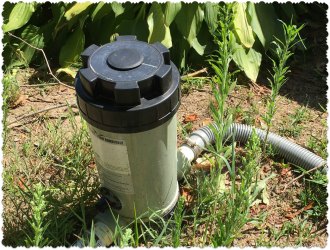
Chlorine floater
A chlorine floater ensures your swimming pool stays sanitized. Swimming pool chlorine floaters typically require a 3-inch chlorine tablet versus the smaller 1-inch variety for smaller spas. The tablet slowly dissolves as it chlorinates the water, without dispersing too much at once. You should never have a chlorine floater in the pool when the people are using the pool.
Automatic Chlorinator
An Automatic Chlorinator is a small device that connects between the filter and the outtake outside of the pool. You put in 3-inch chlorine tablets in the chamber. The tablet slowly dissolves in the chamber, you set the amount of the chlorine to dispense with the filter outtake.
Best Solution
While the Chlorine floater is a cheaper option, your much better off on using an Automatic Chlorinator to dispense chlorine around the pool. The Automatic Chlorinator is a great way to quickly put chlorine evenly around the pool, this is especially true when you are opening the pool for the season. You want to get as much Chlorine in the system as possible and there's no better way than using an Automatic Chlorinator.
Things I have learned
- We have a Super Clear Inline Chlorinator, and I find that it's pretty hard to open. I usually have to use Thermal Latex Coated Gloves to help get a good grip to open the top.
- When we have to put in Chlorine in the Automatic Chlorinator, we put in six tabs at once. This is because it's a pain to open up the device.
- The six tabs last about 2 weeks.
- The O-Ring on the lid doesn't last that long when your store in the lid. When storing the device for the New England Winter, make sure to take out the O-Ring so that it doesn't break apart because of lack of water exposure.
- The O Ring replacement part cost $18.79 at Leslie's Pool! An Automatic Chlorinator cost $74.99.
- We store the Automatic Chlorinator in our basement for the winter.
- I have used both the Automatic Chlorinator and Chlorine floater and have found that the Automatic Chlorinator has produced faster results. I found this out when I was trying to increase the chlorine in our pool and wasn't getting any results with the Chlorine floater, but after running the Automatic Chlorinator in a 24 hour period the Chlorine numbers went up significantly.
PowerFlo Matrix Pool Pump
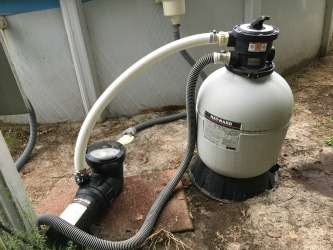
The Hayward PowerFlo Matrix has been engineered as a uniquely superior above ground pool pump. Its large profile and integrated styling makes the PowerFlo Matrix a swimming pool pump like no other.
Features:
- Industrial size strainer basket for large debris collection with minimal maintenance
- Heavy-duty, high performance motor with integrated automatic thermal overload protector for years of operation
- High performance impeller with wide openings to prevent clogging by leaves and debris
Some tips and tricks on using the PowerFlo Matrix pool pump.
- When we got this pump, we were told by several people that a 1 horsepower is perfect for a 25" round pool.
- The worst part of this pump is putting back the strainer cover when cleaning out the basket. The best solution that I have found is to stop the flow of water going into the pump. If you use lubrication on the O-ring you won't have a problem with the ring falling out when trying to seal up the strainer cover.
- There is an air pressure that builds up in the strainer basket area, this may prevent the water from filling up at the pump. The best way to fix this is to open up the basket and then quickly close it.
- When you put on the strainer cover, wait a couple of minutes to see if it's properly sealed. I have found that there are a few water drops when the cover goes on, but after a few seconds the water drops disappear.
- When we got the pump we were told to use a quality PVC pipe to connect the pump to the sand filter. It takes a lot of work to connect the pipe to the two devices. I find that things go a bit easier when I disconnect the top of the sand filter from the base.
- Make sure strainer cover is locked firmly in position and lubricated with "Jack's 327." The Lubrication helps the rubber expand and contract and last longer. This is especially true when you may not use the pool for a season.
- We store the pump in the basement in the winter time.
- It's a good idea to take a picture of the top of the pool pump since it contains a lot of information about the device, including the specific model number that you have.
Sand Filter

Here are some of the information on our Hayward Pro Series filter (Model: S180T), this is approved for fresh or salt water.
The filter can handle 20 gallons per minute. Which means for a 14,645-gallon pool it will take at least 1.63 hours for the filter to process all that water.
The maximum working pressure is 40 PSI. If your pump handles more than that, you???ll need a different type of filter.
The filter can hold 150 LBS ( 68 KGS) of filter sand. It's critical to have exactly that much. If you only put in 125 LBS, you???ll make the filter less effective.
Operating Instructions
- Be sure correct amount of filter sand is in filter tank.
- Set Vari-Flo control valve to BACKWASH. CAUTION: All suction and discharge valves must be open when starting the system. Failure to do so could result in severe personal injury and/or property damage.
- Prime and start pump, allowing tank to fill with water. Once flow is steady out waste line, run in BACKWASH for 2 minutes.
- Stop pump, and set valve to RINSE. Start pump and operate for 1/2 to 1 minute.
- Stop pump, and set valve to FILTER. Start pump. Filter is now operating in normal filter mode.
Filter and Control Valve Functions
- Filter - Set the valve in FILTER for normal filtering. Also use for regular vacuuming.
- Backwash - For cleaning the filter. When filter pressure gauge rises 6-8 PSI (0.41-0.55 bar) above start-up (clean) pressure, stop pump, set valve to BACKWASH. Start pump and backwash until water in the sight glass is clear.
- Rinse - After backwashing, with pump off, set valve to RINSE. Start pump and operate for 1/2 to 1 minute. Stop pump, set valve to FILTER, and start pump for normal filtering.
- Waste - To bypass filter for draining or lowering water level and for vacuuming heavy debris directly to waste.
- Recirculate - Water recirculated through pool system. bypassing filter.
- Closed - Shuts off flow from pump to filter. Useful when you are cleaning debris in the pump.
- Winter - For winterizing. (SP0714T)
Winterizing Instructions
Set control valve in WINTER position, Remove drain cap and throughout drain filter. Drain pump per manufacturer instructions.
We keep the base filter outside, covering it with an installation and a tarp. We put the top inside our basement. I make sure to keep all the loose parts in a bag and attach it to the filter to make opening the pool very easy.
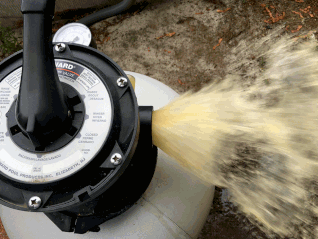
Backwashing the Sand Filter
Water Evaporation
A concern that some above ground pool owners have is when to determine if the pool has a slow leak. You may notice that the pool level slowly goes down, is it a leak or is just natural evaporation.
Adding Water Everyday?
If you're putting water in the pool every day, chances are you have a slow leak problem You should double check all patches to make sure that they are secure. It might be a good idea to double patch areas for a better seal.
There is some pool specialist that can check for the source of the leakage by using sophisticated sound and color dyes testing.
Natural Causes of Water Evaporation
There's no exact amount of water you may loose every day since there are four key factors that determine evaporation: exposure, water temperature, and humidity.
Exposure is how much sun and wind the pool gets everyday. Sun is great to warm up the pool, but those rays also burn off a tiny amount of water. Solar covers are a great way to prevent evaporation from exposure.
Water Temperature - As the pool heats up during the day, it cools off at night. That cooling off period is when some evaporation happens. Turn on the pool light on a nice summer night and you'll see the mist of water evaporating from the pool.Cause
Humidity - The more humid the environment, the less evaporation that will happen. Which means during a period of dry weather, you would expect to see a bit more evaporation.
In addition, constant use of the pool will cause loss of water.
The Bucket Test
The best way to test for evaporation is by using the bucket test.
Take a 5-gallon paint bucket from Lowes or Home Depot. Make a mark with a permanent marker at about the halfway point. Fill the bucket with pool water, so it???s the same temperature and has the same chemicals, up to that point, and set the bucket right beside your swimming pool. Simultaneously, use a pencil to mark the water level on your pool skimmer basket. Mark your skimmer basket so that way you don???t ruin the liner with a marker.
This test will help you determine how much water has evaporated from the bucket and from the pool. Make sure to turn off any pool heater during this test.
PermalinkStabilizer
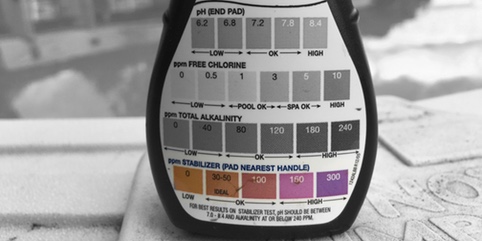
Pool owners use Cyanuric Acid to help prevent the loss of chlorine due to sunlight exposure. Cyanuric Acid is also known as CYA, Conditioner or Stabilizer.
If you have an outdoor swimming pool, you should beware of the Cyanuric Acid levels in your pool. Ignore it and you could be significantly be reducing the chlorine levels in your pool because of the hot summer sun.
Each state has different regulations on the amount public pools should have. In Massachusetts, public pools should have at least 30 and no more than 100 ppm. New Hampshire has no standards. In Maine it should be at lease 10 but no more than 150 ppm. Connecticut public pools should be no more than 100 ppm.
In Florida, which has the most private and public pools than any state, requires that all public pools be no more than 100 ppm.
Check out the various requirements over on Pool Operation Management website.
To high Cyanuric Acid levels?
Having too high Cyanuric levels will weaken the effectiveness of the chlorine. Higher levels will bind with the chlorine, making it slower acting to kill bacteria and microorganisms, and prevent algae. Higher levels will also increase cloudiness in the pool water.
Your best solution to fix a pool with high Cyanuric Acid is to backwash some of the pool water and put in fresh water.
To little Cyanuric Acid?
Too little Cyanuric Acid will results in more of the Chlorine being burn off.
Add the right amount of CYA, Conditioner or Stabilizer based on the current levels and how many gallons are in your pool.
How to test for Cyanuric Acid?
The AquaCheck test strips checks for all the critical pool chemicals. They have an App for expanded water analysis and prescription water balance. (Andriod and iOS) It's a good way to get more detail about what you should do with your pool.
On the AquaCheck test strip container, the follow text appears at the bottom:
For best results on Stabilizer test, pH should be between 7.0 - 8.4 and Alkalinity at or below 240 PPM
In other words, make sure the rest of the pool is balance before being concern with the results of the Stabilizer test.
PermalinkTotal Alkalinity

Pool owners need to have a stable Alkalinity to prevent potential maintenance cost resulting from damage to pool equipment. Pool pump motor life can get cut short because of plugged filters and reduced pipe flow from scale build up.
In addition, Imbalanced Alkalinity may cause burning in the eyes and itchy skin.
The main reason to be concern about the Alkalinity in your pool is because it a measurement of how to balance your pool really is. If you have too high or too low levels of Alkalinity, you're going to have a hard time balancing the pH and Chlorine. Thus you'll be spending lots of money to balance the pool.
The ideal Total Alkalinity should be somewhere between 80 and 120 ppm.
High Total Alkalinity
The results of high Total Alkalinity may be one or more of the following:
- Cloudy water!
- Not able to keep the ph in balance despite regular addition of pH-down;
- Reduced chlorine efficiency resulting in algae growth;
- Added too much baking soda, when trying to increase your total alkalinity.
There are two main chemicals available to lower alkalinity: sodium bisulfate, also known as dry acid, and muriatic acid. You can find muriatic acid at Lowes and Home Depot, check the pool supplies section and/or the paint supply section.
Low Total Alkalinity
The results of a low Total Alkalinity may be one or more of the following:
- Staining of the pool's surfaces
- Slightly Green water
- pH bounce (rapid fluctuations in pH).
To raise Alkalinity: use Sodium Bicarbonate (Baking Soda). Most experts suggest using One pound of Baking Soda for every 6,000 gallons of water. Simply pour the baking soda slowly over the out spout. Just make sure to test the Total Alkalinity levels after a couple of hours to make the pool is fine.
PermalinkpH Levels
Why test the pool for pH levels?
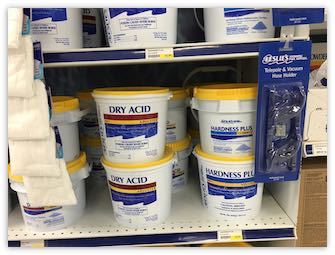
Pool owners use pH test to see how acidity or basic the water is. They measure the pH on a 0 to 14 scale. A reading of '0' means that the water is very acid, and a reading of '14' means the water is basic.
The ideal reading is a 7.4, which is the same pH balance as in the human eye drop. In addition, it gives good chlorine disinfection. Having the pH at 7.4 will help your chlorine be more effective. When your chlorine is effective, you're getting the most use whether you shock the pool or use a Chlorinator.
If you're using the pool testing strips you don't want a bright pink or orange reading.
What causes the pH level to go Down?
Poor Chlorine. Chlorine and pH work together, if you have low Chlorine, then chances are you have low pH levels. Get the pH up first so that your Chlorine can be effective.
What caused the pH level to go Up?
The most common cause is rain water, It doesn't hurt to check the pool immediately after a rain storm. Over time, the sun can burn up the chemicals and cause higher pH levels.
Before you get too concern about the Ph Levels
Check to make sure that your pool is clean. If you have lots of dirt, leaves and debris in the bottom of the pool, focus on getting rid of that before being concern about the pH levels. You're never going to properly balance the pool if you still have a lot of leaves and debris in the pool.
Once the pool is nice and clean, balance the pH then make sure that the Chlorine levels are good.
PermalinkLiquid vs Crystal Shock
What is the best Shock type to buy? When is the best time to use the liquid version and when is the best time to use the power version?

What is Super Shock?
Shock is a sanitizing chemical of water. Shock contains highly concentrated Sodium hypochlorite solutions.
Liquid vs Crystal Super Shock
There is very little difference between the two varieties. When using the Crystal Shock, most manufacturers recommend to delude in a bucket of pool water rather than pouring it directly into the pool.
Using the liquid form just makes it easier to shock the pool, Simply just pour it directly into the pool.
Liquid shock is harder to find, although most pool places do carry it. You'll find the Crystal Shock at most box hardware stores.
Best Time to use Liquid Shock
The best time to use the liquid shock is opening the pool. You won't have crystals falling to the bottom of the pool, only to be picked up by a floor vacuum.
Penalty for Over Shocking
If you over shock the pool, you get a couple of penalties:
Pool Liner Discoloration
If you put in too much Shock you will bleach the pool liner. Very soon you'll have a ring around the pool. The only way to fix this is to replace the liner!
High PH levels
The pool may look cloudy because your PH levels are off the charts. You will need to fix this by adding a "pH Decreaser" to reduce the acid levels. Once you have control of that, the pool should look much better.
Lesson Learned
Make sure to wear proper clothing when applying any type of mega shock to the pool. You could encounter unexpected backsplash which will stain your clothes. Tip: Wear light color clothing, don't forget about the shoes!
Make sure to evenly spread the shock around the pool. I find pouring near the filter. Outtake helps spread it around better.
Once Shock is added to the pool, you must wait 2-3 hours before anyone goes in the pool.
Always apply shock in the morning or early evening. Adding during the middle of the day will only burn off some of the Sodium hypochlorites. Thus losing strength and power of the shock treatment.
If you're getting the Crystal shock at the hardware store, pick up a store 5-gallon bucket to mix the shock. The bucket and cover is a good container to store the crystal shock packets.
You can always use the sand filter backwash to easily get water into the bucket.
PermalinkAbove Ground Pool Supply Essentials
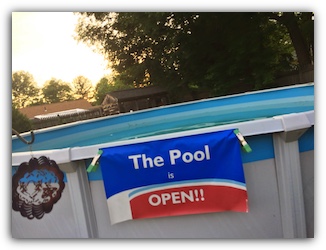
Here's my suggested list of five pool supply essentials that every above ground pool user should have at their disposal at all time. Not having any of these could mean an unscheduled trip to the pool store. That is if they are open.
- Pool Patch Kit with Glue
- Extra Hose with Clamp
- Shock
- Plumber Tape
- Pool Water Test Strips
Pool Patch with Glue
A Pool accident can happen at any time. You never know when something will inadvertently hit the pool. We have had a tree branch and a rock from a lawnmower break the liner - within a few days of each other. Chances are when something happens, you won't have much time to run to the store.
Extra Hose with Clamps
Having an extra hose is extremely valuable when one of the hoses suddenly breaks. This is more likely to happen early in the season when hoses have worn out after many years of use. Extra hose clamps are good in case the old clamps rust out and you can't tighten them any more. Make sure to have at least one available for each length you have.
Just remember to store your hoses inside so the cold weather doesn't shorten the lifespan of the hose.
Extra Super Shock
You never know when you may need to super shock the pool. You don't want AFR or accident to ruin a great swimming weekend.
Remember that liquid super shock does hold its strength for more than one year. Don't over stock on liquid Super Shock - even if it's a good sale!
Plumber Tape
This is handy to have when opening up the pool and you want to make sure that water does leak from the pipes. You can find these a bit cheaper at the big box hardware stores.
Pool Water Test Strips
Always make sure that the pool is well balanced before anyone swims in it. The pool might look super clear, but there might be a chemical imbalance that could cause someone to be sick. It only takes a minute to get a quick read on how safe the pool is.
The Pool Water Test Strips is a quick and easy way to find out if the pool is ready to be used.
It doesn't hurt to have just enough amount of chemicals to balance the pool. It helps to know how many gallons are in your pool.
Always be Prepared
I also keep a spare screwdriver and pliers in the shed. That way if I need to tighten, or loosen any pipe connectors I don't have to go looking for the right tools.
Have all of these will make sure you're ready for a perfect pool summer. Try to think of other supplies that you may need and share your emergency kit ideas!
PermalinkAbout
We have a 24-foot round above ground pool. Every once in a while, I'll blog about our experiences on what works on keeping the pool in mint condition.
Check out all the blog posts.
Blog Schedule
| Thursday | Final Cut Pro |
| Friday | Macintosh |
| Saturday | Internet Tools |
| Sunday | Open Topic |
| Monday | Media Monday |
| Tuesday | QA |
| Wednesday | Python |
Other Posts
- Sand Filter
- Pool Pump (Part 2)
- Checking the Pool Temp after Closing
- Fixing a Green Pool Quickly
- Better Above Ground Pool
- Pool Closing Tips
- Water Evaporation
- Protecting the Pool Cover
- Total Alkalinity
- Hayward Automatic Pool Cleaner
- Gorilla Leaf Rake 2.0
- PowerFlo Matrix Pool Pump
- Pool Tools for Installation
- Above Ground Pool Supply Essentials
- Liquid vs Crystal Shock